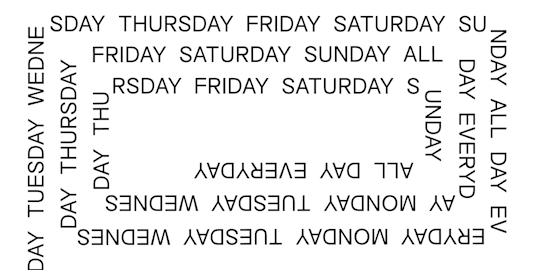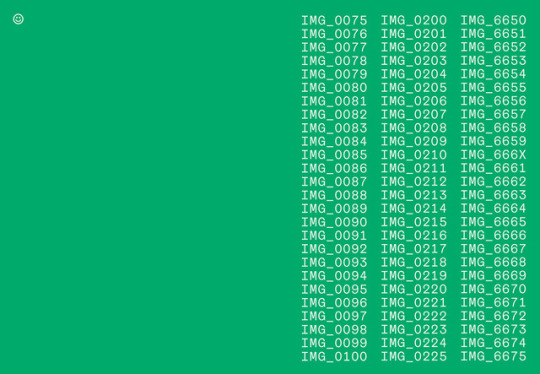Don't wanna be here? Send us removal request.
Text
For my final post this semester I would like to thank Andy for keeping me motivated and to all my classmates to make every class so interesting and entertaining. All the activities we did in class helped us to create our final project, like putting together the pieces of a puzzle, at the end everything made sense. Althought I found some difficulties along the way I can say that I enjoyed this class a lot and I am extremely proud of my outcome. Thanks again for a great semester.
2 notes
·
View notes
Text
Keywords/sentences considered for my final publication:
- community policies
- online censorship
- online platforms
- public sphere
- unseen art
- Censored art
- IRL bodies are controlled by URL rules and regulations.
- Instagram’s rejects
- art sanitising
0 notes
Text

The topic I chose for our final project was the Social Media Community Guidelines that harshly target women bodies - specially female nipples- meaning that many artists that use these online platforms as a place to share their work have to modify their images to make them "safe" or they would be at risk of getting their images removed or their accounts completely banned. Both instagram and Facebook are highly monitored and it was quite hard to find images that weren't already removed or images that weren't already modify. It means that to find the uncensored images I had to go directly to the artist's website or use google. While doing my publication I encountered many posts on social media (as the photo above) with modifications to make them socially acceptable. I wondered why simple artistic nude images of women that weren't pornographic at all had to be censored. Who could be ofended by that? They are beautiful, why make them look offensive? I realised that both Instagram and Facebook are shaping the way artists create and share their art by imposing those unfair guidelines that mainly target the women body and that's a shame. I can say that this publication left me with so many unanswered question but after reading many online discussions I realised I am not the only one. Luckily there are many people who are already working to make these big corporations realised that they can't establish what nipples are socially acceptable or not based on their gender.
0 notes
Text

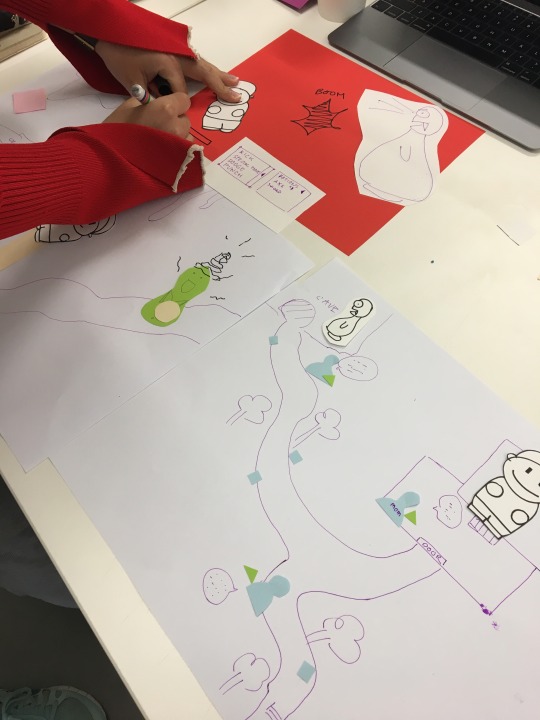


Class exercise — 11/4/17
In this class activity we had to play a retro game online, Nadia and I played Super Mario. After playing the game we had to create the game controllers and characters on paper so the other person could tested it. We tested it and it worked. Then we merged our game with two other groups, one of them had Pokemon and the other one had another version of Mario Bros. The outcome of merging those three games together was amazing because we ended up creating a very entertaining and complex game in which the main character who was a little kid had to find food for his mom, fight big monsters and overcome obstacles in his way as in real life, and there is not a game like that out there yet, it is one of a kind. The main thing I got from this activity is that by sharing our thoughts and ideas with other classmates could be extremely beneficial because it allows you to have an insight of what the other person think, gain some useful feedback and even develop a better concept at the end.
0 notes
Text
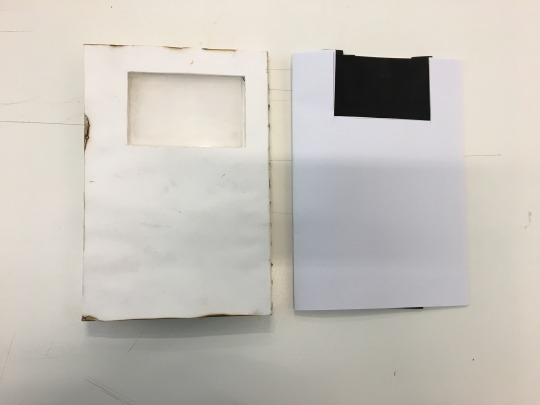
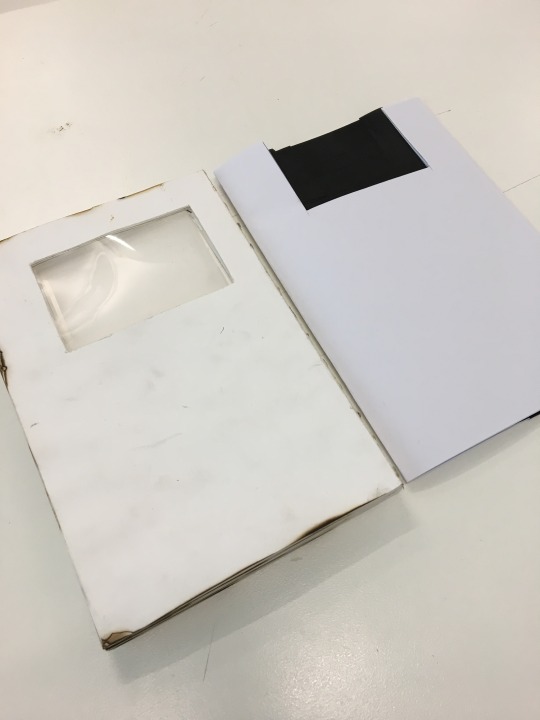
Class exercise — 28/3/17
In this class activity we had to put together another classmate’s prototype by following just the instructions provided. In my case I got Charlie’s prototype instructions (Charlie's protoype left in the photo). It was an interesting activity since it was testing our ability to follow instructions and also to see how much alike would the two outcomes be by following the same instructions. It was a bit challenging since Charlie's instructions has lots of specific steps but the outcome wasn't that different at all but with a few differences. Great to see how two people can get different outcomes by following the same set of instructions.
0 notes
Photo

Reflection
For this assessment I wanted to explore a post-digital topic that really attracts me which is the contradicting Social Media Community guidelines that don't allow certain contents to be posted, such as naked private parts, sexual activity, discriminatory, unlawful, hateful, pornographic photos. It is important to emphasise that although these guidelines don't specify any gender it mostly target female bodies, especially nipples, forcing users to modify their photos to make them “safe to post”.
These guidelines have created lots of controversy since many users and specially artists have got their posts removed and in worst cases their entire accounts blocked. For some artists, the experience has been almost tragic since these Social Media platforms have offered them a space to share their work with the world and losing that space means they also lose all the followers they have gathered.
To depict this concept I decided to gathered artistic photos and videos that have been posted and in some way affected by the community guidelines. And, from this photos I removed the piece portion or part that made it in "unacceptable" in the social network platform in question. I also gathered all the online discussions and articles where people expressed their frustration and confusion over these social media policies.
I designed a publication with thick cards instead of a conventional bound book because I wanted to emphasise the idea of each photo card being a different story. I had to cut holes over the censored parts of each photo to create a sense of sanitisation.
In addition, I created a box to carry the cards made of raw cardboard to go with the crude nature of the publication.
The aesthetic of the book was kept very simple and in a systematic way to reflect the post digital era topic.
I can say that I really enjoyed researching and working on this project since I feel it has broadened my creativity and made me realise about interesting aspects that exist in our ordinary daily lives that sometimes we don't get to perceive.
Pictured above the final box of my publication
2 notes
·
View notes
Text
Statement.
Censored Bodies is a publication that reveals an interesting representation of 21st century society’s contradicting views on the image of the human body. This gallery of selected artistic photographs from different creatives from around the world portray the inconsistencies of online censorship when it comes to dealing with natural images of real raw female bodies. The relationship between artists and social media platforms is complicated, while social media represent an essential tool for emerging artists to be known it also enforces boundaries and this contradicts what art is about, shaping the way artists produce their work to comply with the community guidelines. Facebook and Instagram prohibit posting “naked private parts, sexual activity, discriminatory, unlawful, hateful, pornographic photos”. In contrast with their unforgiving policies regarding sexuality they are more permissive towards depictions of graphic violence. The purpose of this publication is not to dismiss the importance of censorship in our society but to question if the most popular social networks — like Facebook and Instagram — have the right mechanisms of removing inapropiate content while also being up to date with the views of our society at present times.
0 notes
Text
Nudity removed on Pinterest
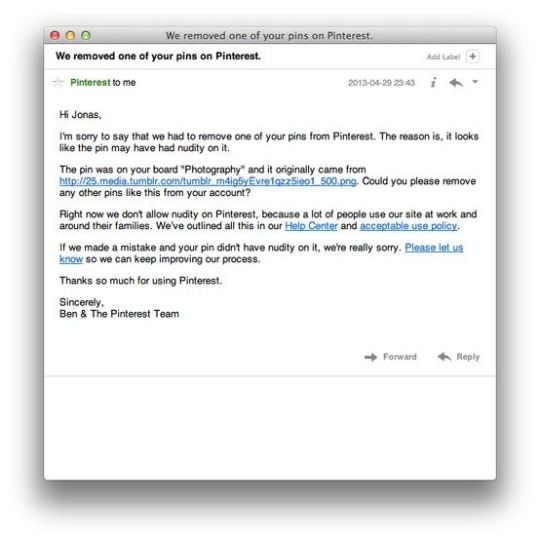
Inspiration for my final prototype.
4 notes
·
View notes
Text
Algorithm detects nudity in images

An algorithm has been designed to tell if somebody in a color photo is naked. Isitnude.com launched earlier this month; its demo page invites you to try it out to test its power in nudity detection. You can choose from a selection of images at the bottom of the page, including pics of Vladimir Putin on horseback and Tiger Woods in golf mode. We tried it out, dragging and dropping a picture of Woods over into the box and the message promptly said "Not nude-G." "You can probably post this."
Other notes on the page include, "We apologize if we didn't get it right, we are improving every day." "Please note that we cannot detect black and white images."
(Algorithmia does not retain images.)
The company behind this effort, Algorithmia, was founded in 2013 to advance algorithm development and use. "As developers ourselves we believe that given the right tools the possibilities for innovation and discovery are limitless."
They said they are building "what we believe to be the next era of programming: a collaborative, always live and community driven approach to making the machines that we interact with better." The community driven API exposes "the collective knowledge of algorithm developers across the globe."
"We're building a community around state-of-the-art algorithm development. Users can create, share, and build on other algorithms and then instantly make them available as a web service."
Lucy Black in I Programmer noted the use advantage. "The idea behind Algorithmia is that where an algorithm already exists you don't need to code your own, instead you can simply paste in its functionality using its cloud-based API."
In his story about Algorithmia and the demo, Brian Barrett in Wired said, "His company is an algorithmic clearing house, taking computational solutions from academia and beyond and offering them to the world at large for a fee."
Why the interest in detecting nudity in photographs?
"A customer came to us trying to run a site that needs to be kid-friendly," said Algorithmia CTO Kenny Daniel in Wired. The customer wanted the ability to screen images with some confidence that they would not be pornographic. Daniel said, "Anybody who's trying to run a community but wants to filter out objectionable content, or keep it kid-friendly, could benefitfrom this same algorithm."
In the company blog this month, they also discussed the rationale in enabling artificial intelligence to detect nudity.
"If there's one thing the internet is good for, it's racy material," said the blog. This is a headache for a number of reasons, including a) it tends to show up where you'd rather it wouldn't, like forums, social media, etc. and b) while humans generally know it when we see it, computers don't so much. We here at Algorithmia decided to give this one a shot."
To give it a shot, they turned to various sources. For one, the result is based on an algorithm by Hideo Hattori and on a paper authored by Rigan Ap-apid, De La Salle University. In the latter's paper, "An Algorithm for Nudity Detection," he presented an algorithm for detecting nudity in color images.
He said, "A skin color distribution model based on the RGB, Normalized RGB, and HSV color spaces is constructed using correlation and linear regression. The skin color model is used to identify and locate skin regions in an image. These regions are analyzed for clues indicating nudity or non-nudity such as their sizes and relative distances from each other. Based on these clues and the percentage of skin in the image, an image is classified nude or non-nude."
Meanwhile, plenty of images with lots of skin are "perfectly innocent," said the blog. "You might say that leaning too much on just color leaves the method, well, tone-deaf. To do better, you need to combine skin detection with other tricks."
Brian Barrett in Wired said "To help weed out false positives, Algorithmia added a few layers of intelligence."
The blog stated that "Our contribution to this problem is to detect other features in the image and using these to make the previous method more fine-grained."
To come up with the algorithm, they turned to the book Human Computer Interaction Using Hand Gestures by Prashan Premaratne, OpenCV's nose detection algorithm and face detection algorithm.
As I Programmer said, the algorithm is still a work in progress. They are still interested in further improvements. "There are countless techniques that can be used in place of or combined with the ones we've used to make an even better solution. For instance, you could train a convolutional neural network on problematic images," they said.
7 notes
·
View notes
Text
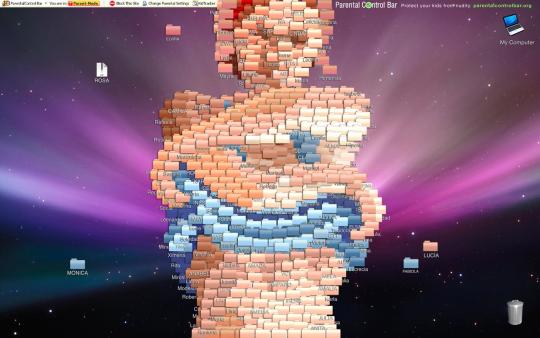
Parental control — Protect your kids from nudity
2 notes
·
View notes
Photo
Bodies and nudity on internet.

Tracy Ma
184 notes
·
View notes
Photo
Interesting and humorous approach to signs using a set of instructions.

»this sign« by micah lexier (+)
3K notes
·
View notes
Photo

From Sturtevant: The Razzle Dazzle of Thinking By Bruce Hainley, ed. by Anne Dressen published 2010
3K notes
·
View notes
Video
youtube
The future of books — This Book Uses Facial Recognition to Judge Whether You Deserve to Read It
You might not want to admit it, but deep down every bookstore shopper knows that picking a new book to read is a fairly superficial process.
We’re tuned to judge books by their covers, despite the advice of clichés. But what happens when the tables are turned, and the covers are judging us?
This is the question at hand for Thijs Biersteker, a Dutch artist who created a book that uses facial recognition to decide whether you are worthy of reading it. As demonstrated in the video, the book scans your face for your emotional state; if it senses that you are either too excited or in a sour mode, it will lock itself shut, preventing you from reading in the wrong frame of mind.
It works like this: You first align your face with the book’s built-in screen, which intentionally resembles the face of a robot out of Fritz Lang’s 1927 dystopian film Metropolis. The book uses facial recognition software made by the company Moore. to gauge your general emotions. If you’re overly amped or skeptical of the book, it won’t open. You must maintain a very serious reading expression, demonstrating your intent to focus on the content of the book.
Once you’ve jumped that hurdle, it’ll send a signal to an Arduino board (a type of open-source computer hardware) that will then know to unlock the book. And voilà — you’re in.
The book itself contains award-winning design and advertising work from 2014. Work that, as Biersteker told Yahoo Tech, has “already been judged and awarded by an international jury, so all that is left is to approach the content of this book without any judgement.” Biersteker, who created the prototype for a 2015 event of the Art Directors Club Netherlands, explained that his thought process behind the project spoke to the anxiety he feels when searching out new literature. “I often worry about my scepticism and judgement getting in my way of amazement,” he wrote on the project website. “Judgement should never hinder relentless enthusiasm of seeing things for the first time.” He also says that, in practice, it garners an immediate emotional reaction from people.“I think there is a lot of Irony in a book that judges you on judgement by judging you,” Biersteker told Yahoo Tech. “The playfulness in combination with the heavy technology makes people smile the moment they see [it]."Biersteker doesn’t have any plans to develop his book lock into a commercial product. But it might be useful to keep in mind the next time you pick up a book, glance at its cover, and think: "But I’m just not that crazy about the color purple.”
Article via The Guardian
5 notes
·
View notes
Photo
Creating imagery from an existing image and repurposing. Also love the distortion.
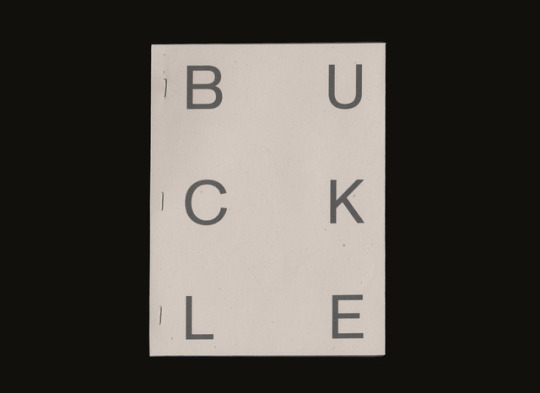


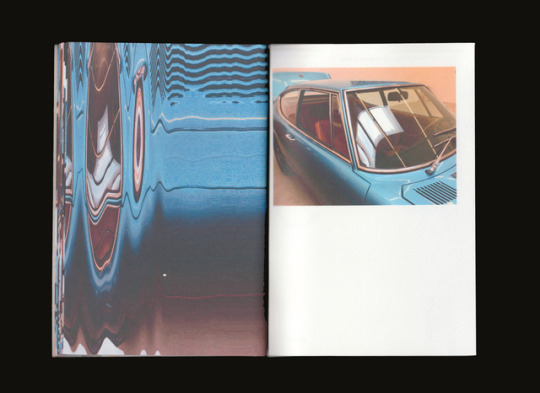
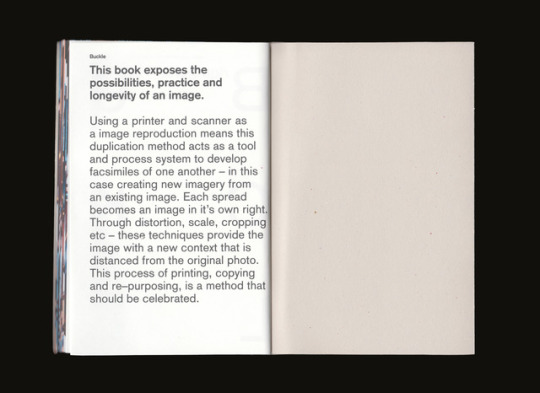
Buckle
2017
This book exposes the possibilities, practice and longevity of an image.
Using a printer and scanner as a image reproduction means this duplication method acts as a tool and process system to develop facsimiles of one another – in this case creating new imagery from an existing image. Each spread becomes an image in it’s own right. Through distortion, scale, cropping etc – these techniques provide the image with a new context that is distanced from the original photo. This process of printing, copying and re–purposing, is a method that should be celebrated.
458 notes
·
View notes
